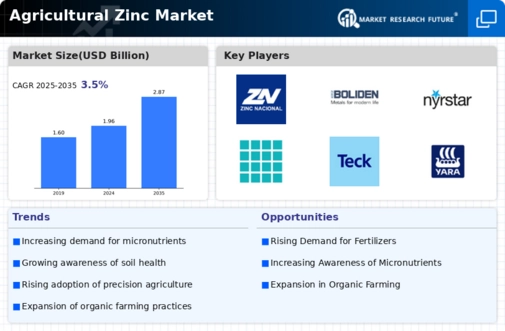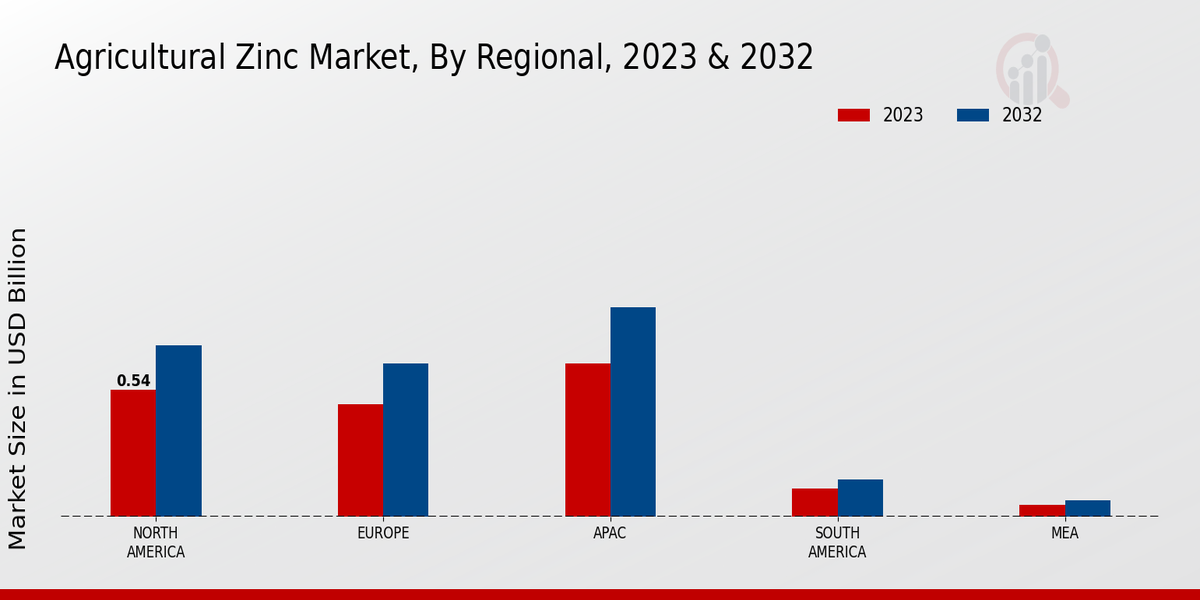Government Initiatives and Support
Various governments worldwide are increasingly recognizing the importance of micronutrients, including zinc, in agriculture. Initiatives aimed at promoting the use of zinc fertilizers are being implemented to enhance soil health and crop productivity. For instance, agricultural policies in several countries encourage the incorporation of micronutrients in farming practices. These supportive measures are likely to drive growth in the Global Agricultural Zinc Market Industry. By 2035, the market is anticipated to grow to 2.87 USD Billion, driven by these initiatives that aim to improve agricultural outputs and ensure food security.
Market Trends and Growth Projections
The Global Agricultural Zinc Market Industry is characterized by several trends that indicate robust growth potential. The market is projected to reach 1.96 USD Billion in 2024, with a compound annual growth rate of 3.52% anticipated from 2025 to 2035. This growth trajectory suggests a strong demand for zinc fertilizers, driven by factors such as increasing agricultural productivity and the need for sustainable farming practices. The market's expansion is likely to be supported by ongoing research and development efforts aimed at improving zinc utilization in crops, further solidifying its importance in global agriculture.
Rising Demand for Zinc in Agriculture
The Global Agricultural Zinc Market Industry experiences a notable increase in demand due to the essential role of zinc in crop production. Zinc is a vital micronutrient that enhances plant growth, improves yield, and boosts resistance to diseases. As global food production needs escalate, particularly in developing regions, the demand for zinc fertilizers is expected to rise. In 2024, the market is projected to reach 1.96 USD Billion, reflecting the growing recognition of zinc's importance in sustainable agriculture. This trend indicates a shift towards more nutrient-efficient farming practices, which could potentially enhance food security globally.
Increasing Global Population and Food Demand
The Global Agricultural Zinc Market Industry is directly impacted by the rising global population and the corresponding increase in food demand. As the world population continues to grow, the pressure on agricultural systems to produce more food intensifies. Zinc plays a critical role in enhancing crop yields and ensuring food quality, making it an essential component of modern agriculture. This growing demand for food is expected to drive the market, with projections indicating a rise to 2.87 USD Billion by 2035. The need for efficient agricultural practices that incorporate micronutrients like zinc is becoming increasingly apparent in addressing global food security challenges.
Growing Awareness of Micronutrient Deficiencies
The Global Agricultural Zinc Market Industry is significantly influenced by the increasing awareness of micronutrient deficiencies in crops. Zinc deficiency is prevalent in many agricultural soils, leading to reduced crop yields and quality. As farmers and agricultural stakeholders become more informed about the detrimental effects of such deficiencies, the demand for zinc-based fertilizers is likely to rise. This awareness is crucial for enhancing crop nutrition and productivity, thereby supporting the market's growth. The projected CAGR of 3.52% from 2025 to 2035 underscores the potential for sustained growth in response to these challenges.
Technological Advancements in Fertilizer Production
Innovations in fertilizer production technology are playing a pivotal role in shaping the Global Agricultural Zinc Market Industry. Advances in manufacturing processes enable the creation of more efficient and effective zinc fertilizers, which can enhance nutrient uptake by plants. These technological improvements not only optimize the use of zinc but also reduce environmental impacts associated with fertilizer application. As the agricultural sector increasingly adopts these advanced products, the market is likely to witness substantial growth. The ongoing development of precision agriculture techniques further supports this trend, aligning with the industry's goals of sustainability and efficiency.










